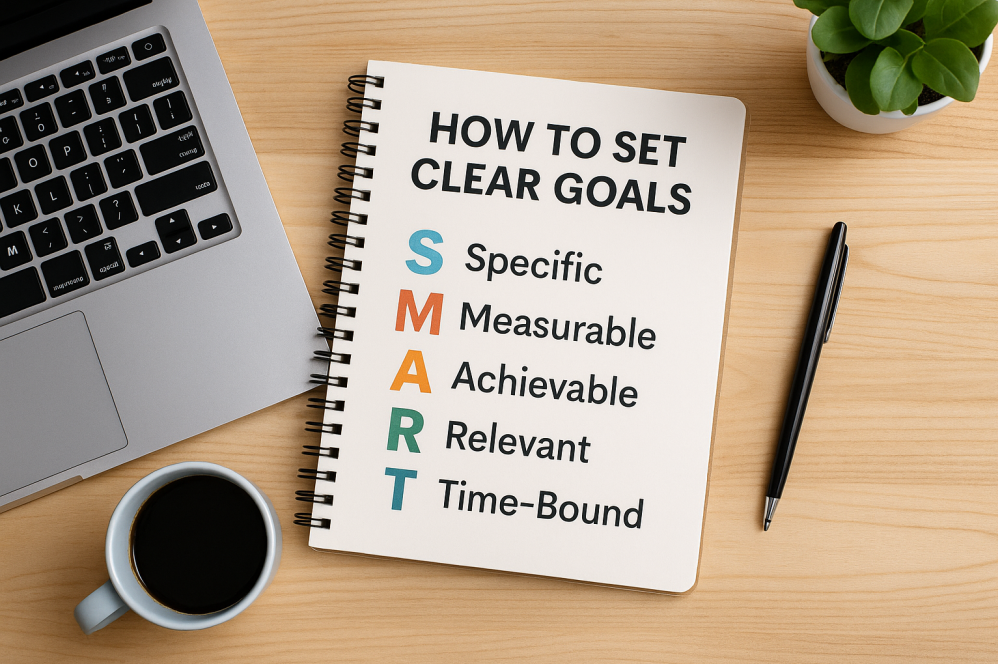“Objectives Key Results Examples | How to Set Clear Goals” is part two in the OKR series. Setting clear, actionable objectives is the foundation of success.

Without well-defined goals, even the best ideas can feel overwhelming or directionless. Entrepreneurs often set ambitious targets like “grow my business” or “increase sales. However, without specificity, these goals lack the structure needed for real progress.
That’s where the OKR (Objectives and Key Results) framework comes in. A strong objective provides clarity and focus, ensuring that every effort aligns with a meaningful outcome.
In this guide, we’ll explore why clear goals matter, how to define them effectively using the SMART framework, and actionable steps to craft objectives that drive real results.
By the end of this article, you’ll be equipped to turn vague aspirations into precise, purpose-driven objectives. Subsequently, this sets the stage for measurable success in your business.
The Importance of Clear Goals
Clear goals are essential because they cut through the noise and lay the groundwork for focused and efficient actions. Without them, you risk wasting effort on misaligned tasks or chasing after priorities that don’t really propel your business forward.
However, having sharply defined objectives means you’re directing energy toward what truly matters.
Moreover, vague goals often result in diluted efforts. Take, for example, the difference between “increase sales” and “achieve a 20% revenue increase in Q1.”
The former might leave teams wondering where to start, while the latter is precise, actionable, and measurable. This clarity moves the needle by keeping everyone on the same page, striving toward specific benchmarks.
Furthermore, clear goals enhance focus and accountability. When everyone knows what the objective is, each team member can prioritize their tasks accordingly. Consequently, this boosts productivity and motivation.
Setting measurable goals is a tangible part of daily operations. They become a rallying point, something visible and motivating, where progress can be tracked and celebrated.
The connection between clear goals and the OKR framework is crucial. For example, these goals lay the groundwork for achieving measurable and achievable key results.
With clear objectives in place, your key results can then focus on how to reach those targets practically and efficiently. Doing so, forms a solid strategy for success.
Defining Goals Using SMART Criteria
Creating clear goals starts with the SMART criteria, a tool that ensures your objectives hit every essential mark. Each component of SMART plays a role in transforming a broad aim into a targeted plan.
Specific goals mean leaving no room for guesswork. Define exactly what accomplishment looks like. Instead of saying “increase brand awareness,” specify “boost website traffic by 20% in three months.” This removes ambiguity and sets expectations.
Measurable implies setting up metrics for success. Ask yourself how you’ll track progress. Numbers make accountability possible. If the objective is “improve customer satisfaction,” tie it to measurable metrics like “achieve a 90% satisfaction rate.”
Achievable goals keep your plans realistic. They shouldn’t be easy but must be possible with the resources at hand. Consider your current assets and constraints to avoid setting up for failure.
Relevant ensures alignment with broader business priorities. Each goal should fit into your overall vision. If the main focus is entering new markets, an objective like “increase social media presence” must link back to this aim.
Time-bound goals have deadlines, which is crucial for consistency and accountability. A timeline pushes each project’s momentum and prevents postponement. If reaching a revenue target, set the deadline as “by the end of Q1” to maintain urgency.
An example of a well-defined SMART goal can be “increase new customer acquisition by 15% in the next quarter by enhancing digital marketing efforts.” It’s direct, actionable, and tied to a schedule.

Steps to Crafting Clear Objectives
Reflecting on your vision helps you paint a clear picture of success. Before jumping into specifics, ask what truly matters to your business. Understand where you see progress or what change is necessary.
Moreover, identifying key focus areas ensures that you’re not spreading your efforts too thin. Choose one or two priority areas, like marketing improvements or operational efficiencies, that align with your business goals.
Writing SMART objectives is your next move. Bring in the criteria of specific, measurable, achievable, relevant, and time-bound to articulate goals that are both meaningful and doable.
Breaking down big goals into sub-objectives makes them manageable. This step adds layers to your main objectives, ensuring each part of the goal is achievable and less overwhelming.
Evaluating for clarity ensures each goal precisely states what you want to achieve and how you’ll measure it. If there’s any confusion, tweaking could be necessary.
Additionally, communicating objectives with your team fosters alignment and shared understanding. This collaboration not only clarifies expectations but also empowers each person to contribute effectively towards shared goals.
Conclusion | Turn Ambition into Achievement
Clarity is the first and most crucial step in achieving your business goals. Without a well-defined objective, it’s easy to get lost in the day-to-day hustle without making meaningful progress.
By using the SMART framework and taking a structured approach to setting objectives, you create a strong foundation for measurable success.
Now it’s your turn! Take a moment to think about one major goal you’d like to accomplish in the next few months. Write it down, refine it using the SMART criteria, and commit to making it happen.
What goal are you working on right now? Share your thoughts and questions in the comments below. I’d love to hear how you’re applying this framework in your entrepreneurial journey.
And don’t forget to check out the next installment in this series: “Crafting Measurable Key Results,” where we’ll get into the next step of the OKR process!
Veron | Entrepreneur | The Way 4Word Enterprises | Premium Member, Wealthy Affiliate